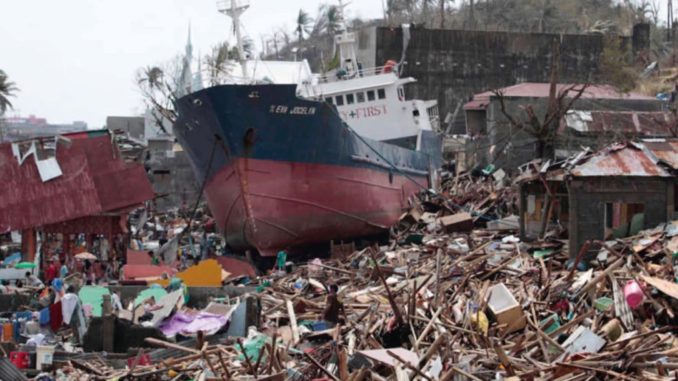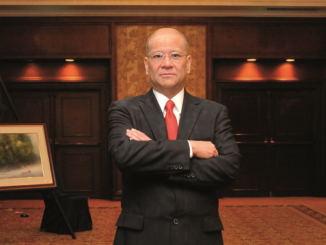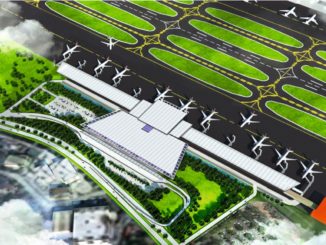
Scientists want the world to reduce global warming drastically, to 1.5°C, instead of the previously agreed upon target set in 2015 of 2°C, a hugely herculean goal that by itself cannot be achieved.
So hitting 1.5°C, the so-called no-bullshit global warming scenario, will require severe lifestyle changes.
Like banning all diesel cars – starting yesterday. Or Filipino farmers to stop planting rice because growing palay requires so much water and so much land that otherwise could be put to better, and more profitable, use. Or stop eating chicken now. Or paying triple for current electricity prices.
Did you know that it takes 2,500 liters of water to produce a kilo of rice? And 4,300 liters of water to produce a kilo of chicken meat?
Making those sacrifices is like asking for a miracle, like the parting of the Red Sea, ala Moses, or the second coming of Jesus Christ, ala Jesus Christ, of course.
But if you don’t endure those sacrifices, temperatures will rise and the oceans will rise and with those, most of Metro Manila and most parts of Luzon will be inundated by rising sea levels. Already, the national capital is sinking at the epochal rate of four inches per year.
Please note that at the rate countries, like the United States and China (both of whom account for half of the world’s pollution), are spewing carbons, the more realistic temperature rise will be 3°C.
So do you want to stop eating rice and chicken and stop driving your diesel car? Or would you rather drown 30 years from now?
Fortunately for me, I would be gone by the time you realize what I am writing about is BS. Or not.
Limiting global warming to 1.5°C would require rapid, far-reaching and unprecedented changes in all aspects of society, the Intergovernmental Panel on Climate Change (IPCC) said on Monday, Oct. 8, 2018 in a new assessment, following a week-long meeting in South Korea of climate scientists and government representatives.
Per the UN IPCC’s Report, a global disaster is just 12 years away. That colossal catastrophe includes a menu of disasters, much of it man-made, including floods, droughts, wildfires and typhoons the severity and frequency of which are something mankind has not experienced – at least in the last three million years.
The special IPCC report says, by 2030 temperatures will rise to 2.7ºF (1.5ºC) above the average of the pre-industrial era— the tipping point of calamity that could make life on earth, as we know it today, next to impossible.
With clear benefits to people and natural ecosystems, limiting global warming to 1.5°C compared to 2°C could go hand in hand with ensuring a more sustainable and equitable society, the IPCC said.
The Special Report on Global Warming of 1.5°C was approved by the IPCC on Oct. 6, 2018, a Saturday, in Incheon, Republic of Korea.
Climate change impacts
The IPCC report highlights a number of climate change impacts that could be avoided by limiting global warming to 1.5°C compared to 2°C, or more.
For instance, by 2100, global sea level rise would be 10 cm lower with global warming of 1.5°C compared with 2°C.
The likelihood of an Arctic Ocean free of sea ice in summer would be once per century with global warming of 1.5°C, compared with at least once per decade with 2°C.
Coral reefs would decline by 70-90% with global warming of 1.5°C, whereas virtually all (> 99%) would be lost with 2°C.
“Every extra bit of warming matters, especially since warming of 1.5°C or higher increases the risk associated with long-lasting or irreversible changes, such as the loss of some ecosystems,” said Hans-Otto Pörtner, co-chair of IPCC Working Group II.
Limiting global warming would also give people and ecosystems more room to adapt and remain below relevant risk thresholds, added Pörtner. The report also examines pathways available to limit warming to 1.5°C, what it would take to achieve them and what the consequences could be.
“The good news is that some of the kinds of actions that would be needed to limit global warming to 1.5°C are already underway around the world, but they would need to accelerate,” said Valerie Masson-Delmotte, co-chair of Working Group I.
The report finds that limiting global warming to 1.5°C would require “rapid and far-reaching” transitions in land, energy, industry, buildings, transport, and cities.
Global net human-caused emissions of carbon dioxide (CO2) would need to fall by about 45% from 2010 levels by 2030, reaching ‘net zero’ around 2050. This means that any remaining emissions would need to be balanced by removing (CO2) from the air.
“Limiting warming to 1.5°C is possible within the laws of chemistry and physics but doing so would require unprecedented changes,” said Jim Skea, co-chair of IPCC Working Group III.
Allowing the global temperature to temporarily exceed or ‘overshoot’ 1.5°C would mean a greater reliance on techniques that remove (CO2) from the air to return global temperature to below 1.5°C by 2100. The effectiveness of such techniques are unproven at large scale and some may carry significant risks for sustainable development, the report notes.
“Limiting global warming to 1.5°C compared with 2°C would reduce challenging impacts on ecosystems, human health and well-being, making it easier to achieve the United Nations Sustainable Development Goals,” said Priyardarshi Shukla, co-chair of IPCC Working Group III.
The decisions we make today are critical in ensuring a safe and sustainable world for everyone, both now and in the future, said Debra Roberts, co-chair of IPCC Working Group II.
The Committee of Parties (COP), or the countries supposedly committed to reducing carbon emissions, had noted with concern that the estimated aggregate greenhouse gas emission levels in 2025 and 2020 resulting from the INDCs (Individually Determined National Contributions, or the commitments by each country to reduce carbon emissions by a certain deadline) do not fall within least-cost 2oC scenarios.
Current commitments
Rather, current commitments by countries could lead to a projected level of 55 gigatons (Gt) in 2020. The COP also noted that much greater emission reduction efforts will be required than those associated with the INDCs in order to hold the increase in the global average temperature to below 2oC above pre-industrial levels by reducing emissions to 40 Gt or to 1.5oC above pre-industrial levels by reducing to a level identified in the special IPCC report.
Media coverage
The Intergovernmental Panel on Climate Change’s (IPCC) special report on 1.5oC, published Oct. 8, 2018 following has received ample media coverage globally, according to The Guardian newspaper of London.
The New York Times says the “landmark report…paints a far more dire picture of the immediate consequences of climate change than previously thought and says that avoiding the damage requires transforming the world economy at a speed and scale that has ‘no documented historic precedent’.”
The Washington Post says “the world has barely 10 years to get climate change under control”, which echoes CNN’s focus. An AFP story published before the report was published says that Saudi Arabia had threatened to block key findings within the report. It is believed that the Saudis failed in their attempts, though.
BBC news says: “It’s the final call, say scientists, the most extensive warning yet on the risks of rising global temperatures. Their dramatic report on keeping that rise under 1.5oC states that the world is now completely off track, heading instead towards 3oC. Staying below 1.5oC will require ‘rapid, far-reaching and unprecedented changes in all aspects of society’. It will be hugely expensive, the report says, but the window of opportunity is not yet closed.”
The Guardian says the IPCC report warns “there is only a dozen years for global warming to be kept to a maximum of 1.5oC, beyond which even half a degree will significantly worsen the risks of drought, floods, extreme heat and poverty for hundreds of millions of people”.
The Guardian also included a timeline showing how the IPCC “got to 1.5oC threshold”, a live blog and a round-up of reaction.
For its part, The Financial Times says the “world is on track to overshoot the targets of the Paris climate agreement and warm by 3oC by the end of the century, a level that would disrupt life around the planet”.
Reuters says the IPCC Special Report concludes that “massive societal changes needed to meet lower global warming target world needs”.
The IPCC special report will be a key scientific input into the Katowice Climate Change Conference in Poland in December, when governments review the Paris Agreement to tackle climate change.
“With more than 6,000 scientific references cited and the dedicated contribution of thousands of expert and government reviewers worldwide, this important report testifies to the breadth and policy relevance of the IPCC,” said Hoesung Lee, chair of the IPCC.
Ninety-one authors and review editors from 40 countries prepared the IPCC report in response to an invitation from the United Nations Framework Convention on Climate Change (UNFCCC) when it adopted the Paris Agreement in 2015.
The report’s full name is Global Warming of 1.5°C, an IPCC special report on the impacts of global warming of 1.5°C above pre-industrial levels and related global greenhouse gas emission pathways, in the context of strengthening the global response to the threat of climate change, sustainable development, and efforts to eradicate poverty.
“One of the key messages that comes out very strongly from this report is that we are already seeing the consequences of 1°C of global warming through more extreme weather, rising sea levels and diminishing Arctic sea ice, among other changes,” said Panmao Zhai, co-chair of IPCC Working Group I.
“This report gives policymakers and practitioners the information they need to make decisions that tackle climate change while considering local context and people’s needs. The next few years are probably the most important in our history,” she said.
The IPCC is the leading world body for assessing the science related to climate change, its impacts and potential future risks, and possible response options.
The report was prepared under the scientific leadership of all three IPCC working groups. Working Group I assesses the physical science basis of climate change; Working Group II addresses impacts, adaptation and vulnerability; and Working Group III deals with the mitigation of climate change.
Paris Agreement
The Paris Agreement adopted by 195 nations at the 21st Conference of the Parties to the UNFCCC in December 2015 included the aim of strengthening the global response to the threat of climate change by “holding the increase in the global average temperature to well below 2°C above pre-industrial levels and pursuing efforts to limit the temperature increase to 1.5°C above pre-industrial levels.”
The United States, under President Trump, pulled out from the Paris Agreement.
As part of the decision to adopt the Paris Agreement, the IPCC was invited to produce, in 2018, a Special Report on global warming of 1.5°C above pre-industrial levels and related global greenhouse gas emission pathways.
The IPCC accepted the invitation, adding that the Special Report would look at these issues in the context of strengthening the global response to the threat of climate change, sustainable development, and efforts to eradicate poverty.
Global Warming of 1.5°C is the first in a series of Special Reports to be produced in the IPCC’s Sixth Assessment Cycle. Next year the IPCC will release the Special Report on the Ocean and Cryosphere in a Changing Climate, and Climate Change and Land, which looks at how climate change affects land use.
The Summary for Policymakers (SPM) presents the key findings of the Special Report, based on the assessment of the available scientific, technical and socio-economic literature relevant to global warming of 1.5°C.
Not much time left
The Intergovernmental Panel on Climate Change (IPCC) released this week its most alarming report yet on climate change, says The Inquirer editorial of Oct. 12, 2018.
IPCC said that damage to the planet would be irreparable should the world fail to keep global warming to 1.5°C within the next 12 years.
“One of the key messages of the report, written by more than 90 scientists, is that the world has already warmed 1°C from pre-industrial levels, and is already seeing the consequences,” notes the Inquirer.
Says the editorial: “Limiting human-caused warming to even just a half-degree celsius, it emphasized, will leave the planet’s weather, health and ecosystems in much better shape.
“The Philippines was among the 195 countries that signed the landmark Paris Agreement, which commits to keep the global temperature rise this century well below 2°C from preindustrial levels, and pursue efforts to limit the temperature increase even further to 1.5°C.
“A 2°C increase is projected to lead to catastrophic and irreversible changes that could make the world less habitable.
“These effects include boiling-hot climates, rising sea levels, and extreme weather disturbances such as supertyphoons and hurricanes — even stronger than what’s been seen so far — that could leave millions of people homeless and even stateless, wiping out ecosystems, affecting agricultural production, spurring food shortages and inundating low-lying countries.
“To accomplish the highly challenging 1.5°C goal, scientists said drastic measures have to be taken. Governments and businesses need to adopt policies that would shift operations and livelihoods to clean energy, to cut down on greenhouse gas emissions.
“Individuals must pursue lifestyle changes such as eating less meat (livestock emits huge quantities of methane), moving to a smaller dwelling to effect minimal use of resources, using more sustainable products, walking or taking public transport instead of driving, and carpooling.
Meaning for PH
“But what does this mean for a developing country like the Philippines, where about 22 million people are impoverished and an estimated 44% of the urban population are slum dwellers?”
“In addition, more than half of the population, or 62% , live in coastal zones, exposing them to natural calamities such as the average 20 typhoons that enter the country every year.”
“This year, some 17 tropical cyclones have already hit, with Typhoon “Ompong” in September affecting more than 270,000 people in 30 provinces and damaging about P17 billion worth of crops.”
“The country also continues to lose its rich biodiversity and is considered one of the world’s “most threatened hotspots,” according to the 2017 assessment report by the Climate Change Commission (CCC), an agency under Malacañang.”
“Key drivers of biodiversity loss include land conversion, deforestation due to logging, mining and pollution. The tragic effects of unregulated mining and quarrying were recently seen in Benguet and Cebu, with at least 90 deaths from landslides.”
“Climate change expert Rosa Perez, one of the IPCC report’s authors, warned that the Philippines could see the extinction of hundreds of endemic species and 99% of coral reefs, food shortages and extreme weather disturbances in the future.”
“IPCC scientists said that while time is running out to avert the severest consequences of global warming, it can still be done “within the laws of physics and chemistry,” and with the political will of governments.”
The Duterte administration has earmarked about P1 billion under the national climate fund to “help local communities build resiliency,” but there appears to be little monitoring of how these funds are being used.”



